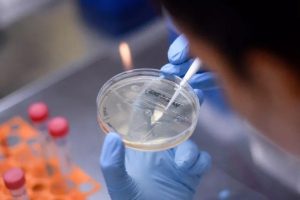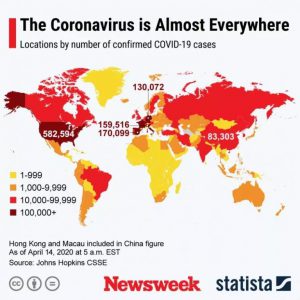APRIL 14, 2020

A researcher, unrelated to the study, works on the development of a vaccine against the new coronavirus COVID-19, in Belo Horizonte, state of Minas Gerais, Brazil, on March 26, 2020. DOUGLAS MAGNO/AFP via Getty Images
Scientists have reported in a preliminary study what they believe is the first significant mutation of the coronavirus which causes the COVID-19 disease. But experts told Newsweek it is unlikely the finding will jeopardize efforts to create a vaccine to prevent COVID-19.
The authors of the study examined the genetic make-up of 106 samples of SARS-CoV-2, the name of the coronavirus which causes COVID-19, from a database.
They compared these with 39 genome sequences of SARS, the virus which triggers severe acute respiratory syndrome (SARS) and started an outbreak in 2002. The complete or near-complete data on SARS-CoV-2 spanned 54 records from the US., 35 form China, three from Spain, two for Brazil, and one each from Australia, Finland, India, Italy, Nepal, South Korea, and Sweden.
The team published their findings on the website bioRxiv, meaning it hasn’t undergone the rigorous peer review process required to publish in scientific journals. Releasing studies this way enables scientists to prompt debate on a topic, which can be helpful in a fast-changing situation like a pandemic.
Sars-CoV-2, the COVID-19 virus, was found to have a “much lower” mutation rate and genetic diversity than SARS during the 2002 and 2003 outbreak.
“A relatively stable genome of SARS-CoV-2 is a good indication for the epidemic control, as less mutation raises the hope of the rapid development of [a valid] vaccine and antiviral drugs,” the researchers wrote.
For instance, the genes which code for the COVID-19 virus’ spike protein, which enables it to attach to human cells, largely stayed the same.
Analysis of one sample collected in India on January 27, 2020 showed the “first evidence” of a “significant” mutation of SARS-CoV-2, which appeared to make it less able to bind to a receptor on human cells called ACE2.
The researchers said this finding “raises the alarm that the ongoing vaccine development may become futile in future epidemic if more mutations were identified.”
Commenting on their results as a whole, the team wrote: “As the virus continues to spread rapidly around the world, and more genomic data is accumulated, the evolution and mutation dynamics of SARS-CoV-2 still need to be monitored closely.”
They said: “We confirmed that SARS-CoV-2 has a relatively low mutation rate but also proved that novel mutation with varied virulence and immune characteristics have already emerged.”
Jenna Macciochi, lecturer in immunology at the University of Sussex who did not work on the study, told Newsweek: “I don’t think this [the study] tells us much although it’s an important aspect of the virology of this pandemic to monitor.”
Macciochi explained: “Every virus will have a period of adaptation when it enters a new host.” As SARS-CoV-2 is spreading with relative ease, “there is less selective pressure for it to mutate dramatically,” she said.
“Small mutations would be expected with any virus. The emerged mutation in this report appears to reduce binding to ACE2 meaning less virulence which could potentially mean less ability to infect. But as this is an isolated report this doesn’t necessarily mean vaccine attempts are futile,” said Macciochi.
Asked whether the findings have implications for the creation of a vaccine, Macciochi said: “According to the study it has a lower mutation rate particularly the s-protein [spike] which is the target of many vaccines.
“This is reassuring that this is a good target for vaccines. We do not know if the changes reported would change the ability of protective antibodies against spike to be redundant.”
The fact the study was not peer-reviewed and involved a small sample limits the significance of the findings, Macciochi argued. In addition, the data from the new strain was collected at the end of January in India and it would be useful to see how this affected the severity of the disease, she said.
Ian Jones, professor of virology at the U.K.’s University of Reading who also did not work on the study, told Newsweek: “While analysis of the virus to date has shown a sporadic set of mutations as expected of RNA viruses, including coronaviruses, there has been no obvious selection of distinct variants.”
RNA refers to the genetic material of the virus, and germs of this type are known to mutate easily as they spread.
“Even when this has been suggested, as in this Taiwanese study, the key part of the virus required for vaccine design has not changed. Thus, a very thin silver lining to the epidemic is that vaccine and therapeutics tested now should be equally applicable later in the year or in years to come.”
According to Johns Hopkins University, more the 1.9 million COVID-19 cases have been confirmed around the world, almost 121,000 people have died, and nearly 465,000 have recovered. As the Statista map below shows, the virus has spread to every continent except Antarctica.

This infographic shows the spread of COVID-19 cases around the world as of April 14. – Statista
Centers for Disease Control and Prevention Advice on Using Face Coverings to Slow Spread of COVID-19
- CDC recommends wearing a cloth face covering in public where social distancing measures are difficult to maintain.
- A simple cloth face covering can help slow the spread of the virus by those infected and by those who do not exhibit symptoms.
- Cloth face coverings can be fashioned from household items. Guides are offered by the CDC. (https://www.cdc.gov/coronavirus/2019-ncov/prevent-getting-sick/diy-cloth-face-coverings.html)
- Cloth face coverings should be washed regularly. A washing machine will suffice.
- Practice safe removal of face coverings by not touching eyes, nose, and mouth, and wash hands immediately after removing the covering.
World Health Organization advice for avoiding spread of coronavirus disease (COVID-19)
Hygiene advice
- Clean hands frequently with soap and water, or alcohol-based hand rub.
- Wash hands after coughing or sneezing; when caring for the sick; before, during and after food preparation; before eating; after using the toilet; when hands are visibly dirty; and after handling animals or waste.
- Maintain at least 1 meter (3 feet) distance from anyone who is coughing or sneezing.
- Avoid touching your hands, nose and mouth. Do not spit in public.
- Cover your mouth and nose with a tissue or bent elbow when coughing or sneezing. Discard the tissue immediately and clean your hands.
Medical advice
- Avoid close contact with others if you have any symptoms.
- Stay at home if you feel unwell, even with mild symptoms such as headache and runny nose, to avoid potential spread of the disease to medical facilities and other people.
- If you develop serious symptoms (fever, cough, difficulty breathing) seek medical care early and contact local health authorities in advance.
- Note any recent contact with others and travel details to provide to authorities who can trace and prevent spread of the disease.
- Stay up to date on COVID-19 developments issued by health authorities and follow their guidance.
Mask and glove usage
- Healthy individuals only need to wear a mask if taking care of a sick person.
- Wear a mask if you are coughing or sneezing.
- Masks are effective when used in combination with frequent hand cleaning.
- Do not touch the mask while wearing it. Clean hands if you touch the mask.
- Learn how to properly put on, remove and dispose of masks. Clean hands after disposing of the mask.
- Do not reuse single-use masks.
- Regularly washing bare hands is more effective against catching COVID-19 than wearing rubber gloves.
- The COVID-19 virus can still be picked up on rubber gloves and transmitted by touching your face.
Courtesy/Source: Newsweek






































































































